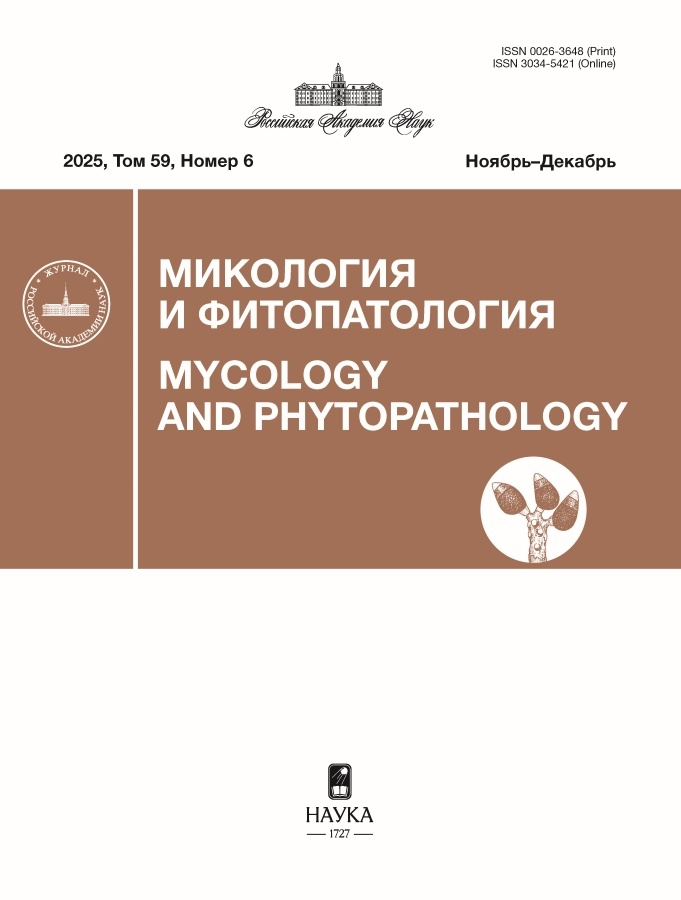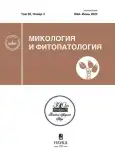Расовый состав и изменчивость гена ToxA в географически отдаленных популяциях Pyrenophora tritici-repentis
- Авторы: Мироненко Н.В.1, Орина А.С.1, Коваленко Н.М.1, Зубко Н.Г.1
-
Учреждения:
- Всероссийский НИИ защиты растений
- Выпуск: Том 58, № 3 (2024)
- Страницы: 246-253
- Раздел: ГРИБЫ – ВОЗБУДИТЕЛИ БОЛЕЗНЕЙ РАСТЕНИЙ
- URL: https://journals.rcsi.science/0026-3648/article/view/265155
- DOI: https://doi.org/10.31857/S0026364824030064
- EDN: https://elibrary.ru/vitnfb
- ID: 265155
Цитировать
Полный текст
Аннотация
Возбудитель желтой пятнистости пшеницы – аскомицет Pyrenophora tritici-repentis – продуцирует специфичные некротрофные эффекторы Ptr ToxA, Ptr ToxB и Ptr ToxC, индуцирующие некроз и хлороз на листьях восприимчивых сортов. По способности штаммов P. tritici-repentis продуцировать отдельные некротрофные эффекторы или их комбинации различают восемь рас патогена. Мониторинг расового состава популяций P. tritici-repentis необходим для оценки эволюционного потенциала возбудителя и разработки методологии создания сортов зерновых культур с длительной устойчивостью. Нами проанализированы 179 моноконидиальных штаммов P. tritici-repentis из популяций Казахстана и России в 2020–2022 гг. Выявлено повсеместное распространение рас 2 и 4, штаммы которых присутствовали в каждой изученной популяции P. tritici-repentis с частотой 2–36 и 7–82 % соответственно. Отмечено доминирование представителей авирулентной расы 4, доля которой составила 27% среди всех проанализированных штаммов P. tritici-repentis. Молекулярная идентификация генов ToxA и ToxB, а также toxb – гомолога гена ToxB – у 118 штаммов P. tritici-repentis из шести популяций выявила присутствие гена ToxA у 69% изученных штаммов гриба. Ген ToxB не был обнаружен ни у одного штамма P. tritici-repentis, тогда как ген toxb встречался спорадически и был выявлен в геноме 18 штаммов P. tritici-repentis (9%), большинство из которых были отнесены к авирулентной расе 4. При идентификации гена ToxA были выявлены десять штаммов P. tritici-repentis, у которых амплифицировался продукт размером ≈800 п.н., значительно превышающий ожидаемый, что объясняется наличием инсерции в амплифицируемом участке гена ToxA. Такие гены были названы ToxAL. Все штаммы P. tritici-repentis с вариантом ToxAL были отнесены к расам 4 и 5, не образующим некротрофный эффектор Ptr ToxA. Структура гена ToxAL и его белкового продукта является предметом дальнейших исследований.
Об авторах
Н. В. Мироненко
Всероссийский НИИ защиты растений
Автор, ответственный за переписку.
Email: nina2601mir@mail.ru
Россия, Санкт-Петербург
А. С. Орина
Всероссийский НИИ защиты растений
Email: orina-alex@yandex.ru
Россия, Санкт-Петербург
Н. М. Коваленко
Всероссийский НИИ защиты растений
Email: nadyakov@mail.ru
Россия, Санкт-Петербург
Н. Г. Зубко
Всероссийский НИИ защиты растений
Email: sacura0@yandex.ru
Россия, Санкт-Петербург
Список литературы
- Abdullah S., Sehgal S.K., Ali S. Race diversity of Pyrenophora tritici-repentis in South Dakota and response of predominant wheat cultivars to tan spot. J. Plant Pathol. Microbiol. 2017. V. 8. P. 409. https://doi.org/10.4172/2157-7471.1000409
- Afanasenko O.S., Novozhilov K.V. Problems of rational use of genetic resources for plant disease resistance. Ekologicheskaya genetika. 2009. V 7(2). P. 38–42 (in Russ.).
- Ali S., Francl L.J., De Wolf E.D. First report of Pyrenophora tritici-repentis race 5 from North America. Plant Dis. 1999. V. 83. P. 591. https://doi.org/10.1094/PDIS.1999.83.6.591A
- Amaike S., Ozga J.A., Basu U. et al. Quantification of ToxB gene expression and formation of appressoria by isolates of Pyrenophora tritici-repentis differing in pathogenicity. Plant Pathology. 2008. V. 57. P. 623–633. https://doi.org/10.1111/j.1365-3059.2007.01821.x
- Andrie R.M., Pandelova I., Ciuffetti L.M. A combination of phenotypic and genotypic characterization strengthens Pyrenophora tritici-repentis race identification. Phytopathol. 2007. V. 97. P. 694-701. https://doi.org/10.1094/PHYTO-97-6-0694
- Antoni E.A., Rybak K., Tucker M.P. et al. Ubiquity of ToxA and absence of ToxB in Australian populations of Pyrenophora tritici-repentis. Austral. Plant Pathol. 2010. V. 39. P. 63–68. https://doi.org/10.1071/AP09056
- Benslimane H. Virulence phenotyping and molecular characterization of a new virulence type of Pyrenophora tritici-repentis the causal agent of tan spot. Plant Pathol. 2018. V. 34(2). P. 139–142. https://doi.org/10.5423/ppj.nt.07.2017.0150
- Ciuffetti L.M., Tuuori R.P., Gaventa J.M. A single gene encodes a selective toxin causal to the development of tan spot of wheat. The Plant Cell. 1997. V. 9. P. 135–144.
- Guo J., Shi G., Kalil A. et al. Pyrenophora tritici-repentis Race 4 Isolates cause disease on tetraploid wheat. Phytopathology. 2020. V. 110. P. 1781–1790. https://doi.org/10.1094/phyto-05-20-0179-r
- Kamel S., Cherif M., Hafez M. et al. Pyrenophora tritici- repentis in Tunisia: race structure and effector genes. Front. Plant Sci. 2019. V. 10. P. 1562. https://doi.org/10.3389/fpls.2019.01562
- Lamari L., Bernier C.C. Virulence of isolates of Pyrenophora tritici-repentis on 11 wheat cultivars and cytology of the differential host reaction. Can. J. Plant Pathol. 1989. V. 11. P. 284–290.
- Lamari L., Sayoud R., Boulif M. et al. Identification of a new race in Pyrenophora tritici-repentis: implication for the current pathotype classification system. Can. J. Plant Pathol. 1995. V. 17. P. 312–318. https://doi.org/10.1080/07060669509500668
- Lamari L., Strelkov S.E. The wheat – Pyrenophora tritici-repentis interaction: progress towards an understanding of tan spot disease. Can. J. Plant Pathol. 2010. V. 32(1). P. 4–10. https://doi.org/10.1080/07060661003594117
- Martinez J.P., Oesch N.W., Ciuffetti L.M. Characterization of the multiple-copy host-selective toxin gene, ToxB, in pathogenic and nonpathogenic isolates of Pyrenophora tritici-repentis. Mol. Plant-Microbe Interact. 2004. V. 17. P. 467–474. https://doi.org/10.1094/mpmi.2004.17.5.467
- Martinez J.P., Ottum S.A., Ali S., Francl L.J., Ciuffetti L.M. Characterization of the ToxB gene from Pyrenophora tritici-repentis. Mol. Plant-Microbe Interact. 2001. V. 14. P. 675–677. https://doi.org/10.1094/mpmi.2001.14.5.675.
- Mikhaylova L.A., Mironenko N.V., Kovalenko N.M. Populations of Pyrenophora tritici-repentis in the North Caucasus and North-West Russia: the racial composition and dynamics of virulence. Mikologiya i fitopatologiya. 2014. V. 8(6). P. 393–400 (in Russ.).
- Mikhaylova L.A., Gultyaeva E.I., Kokorina N.M. Laboratory methods for cultivating the wheat tan spot pathogen Pyrenophora tritici-repentis. Mikologiya i fitopatologiya. 2002. V. 36(1). P. 63–67 (in Russ.).
- Mikhaylova L.A., Kovalenko N.M., Mironenko N.V. et al. Populations of Pyrenophora tritici-repentis on the territory of Russia. Mikologiya i fitopatologiya. 2015. V. 49(4). P. 257–261 (in Russ.).
- Mikhaylova L.A., Ternyuk I.G., Mironenko N.V. Characteristic of Pyrenophora tritici-repentis populations by their virulence. Mikologiya i fitopatologiya. 2010. V. 44(3). P. 263–272 (in Russ.).
- Mikhaylova L.A., Ternyuk I.G., Mironenko N.V. Structure of Pyrenophora tritici-repentis populations from European part of Russia by virulence. Mikologiya i fitopatologiya. 2007. V. 41(3). P. 269–275 (in Russ.).
- Mironenko N.V., Baranova O.A., Kovalenko N.M. et al. Frequency of ToxA gene in North Caucasian and North-West Russian populations of Pyrenophora tritici-repentis. Mikologiya i fitopatologiya. 2015. V 49(5). P. 325–329 (in Russ.).
- Mironenko N.V., Kovalenko, N.M., Baranova O.A. Characteristics of the geographically distant populations of Pyrenophora tritici-repentis in terms of virulence and ToxA and ToxB toxin-forming genes. Vestnik zashchity rasteniy. 2019. V. 1. P. 24–29 (in Russ.). http://doi.org/10.31993/2308-6459-2019-1(99)-24-29
- Moolhuijzen P.M., See P.T., Oliver R.P. et al. Genomic distribution of a novel Pyrenophora tritici-repentis ToxA insertion element. PLOS One. 2018. V. 13(10). Art. e0206586. https://doi.org/10.1371/journal.pone.0206586
- Moreno M.V., Stenglein S., Perelló A.E. Distribution of races and Tox genes in Pyrenophora tritici-repentis isolates from wheat in Argentina. Trop. Plant Pathol. 2015. V. 40. P. 141–146. https://doi.org/10.1007/s40858-015-0011-2
- Murray H.G., Thompson W.F. Rapid isolation of high molecular weight DNA. Nucleic Acids Res. 1980. V. 8. P. 4321–4325.
- Šárová J., Hanzalová A., Bartoš P. Races of Pyrenophora tritici-repentis in the Czech Republic. Acta Agrobotanica. 2005. V. 58. P. 73–78. https://doi.org/10.5586/aa.2005.011
- See P.T., Marathamuthu K.A., Iagallo E.M. et al. Evaluating the importance of the tan spot ToxA–Tsn1 interaction in Australian wheat varieties. Plant Pathol. 2018. V. 67. P. 1066–1075. https://doi.org/10.1111/ppa.12835
- Shi G., Kariyawasam G., Liu S. et al. A conserved hypothetical gene is required but not sufficient for Ptr ToxC production in Pyrenophora tritici-repentis. Molecular Plant-Microbe Interactions. 2022. V. 35(4). P. 336–348. https://doi.org/10.1094/mpmi-12-21-0299-R.
- Strelkov S.E., Lamari L. Host-parasite interactions in tan spot Pyrenophora tritici-repentis of wheat. Can. J. Plant Pathol. 2003. V. 25(4). P. 339–349. https://doi.org/10.1080/07060660309507089.
- Wegulo S.N., Breathnach J.A., Baenziger P.S. Effect of growth stage on the relationship between tan spot and spot blotch severity and yield in winter wheat. Crop Protection. 2009. V. 28(8). P. 696–702. https://doi.org/10.1016/j.cropro.2009.04.003
- Афанасенко О.С., Новожилов К.В. (Afanasenko, Novozhilov) Проблемы рационального использования генетических ресурсов устойчивости растений к болезням // Экологическая генетика. 2009. T. 7. № 2. С. 38–42.
- Мироненко Н.В., Баранова О.А., Коваленко Н.М. и др. (Mironenko et al.) Частота гена ToxA в популяциях Pyrenophora tritici-repentis на Северном Кавказе и северо-западе России // Микология и фитопатология. 2015. T. 49. № 5. С. 325–329.
- Мироненко Н.В., Баранова О.А., Коваленко Н.М. (Mironenko et al.) Характеристика географически отдаленных популяций Pyrenophora tritici-repentis по вирулентности и генам токсинообразования ToxA и ToxB // Вестник защиты растений. 2019. Т. 1. № 99. С. 24–29.
- Михайлова Л.А., Гультяева Е.И., Кокорина Н.М. (Mikhaylova et al.) Лабораторные методы культивирования возбудителя желтой пятнистости пшеницы Pyrenophora tritici-repentis // Микология и фитопатология. 2002. Т. 36. № 1. С. 63–67.
- Михайлова Л.А., Тернюк И.Г., Мироненко Н.В. (Mikhaylova et al.) Структура популяций Pyrenophora tritici-repentis из европейской части России по признаку вирулентности // Микология и фитопатология. 2007. Т. 41. № 3. С. 269–275.
- Михайлова Л.А., Тернюк И.Г., Мироненко Н.В. (Mikhaylova et al.) Характеристика популяций Pyrenophora tritici-repentis по признаку вирулентности // Микология и фитопатология. 2010. Т. 44. № 3. С. 263–272.
- Михайлова Л.А., Мироненко Н.В, Коваленко Н.М. (Mikhaylova et al.) Популяции Pyrenophora tritici-repentis на Северном Кавказе и северо-западе России: расовый состав и динамика вирулентности // Микология и фитопатология. 2014. Т. 48. № 6. С. 393–400.
- Михайлова Л.А., Коваленко Н.М., Мироненко Н.В. и др. (Mikhaylova et al.) Популяции Pyrenophora tritici-repentis на территории России // Микология и фитопатология. 2015. Т. 49. № 4. С. 257–261.
Дополнительные файлы










